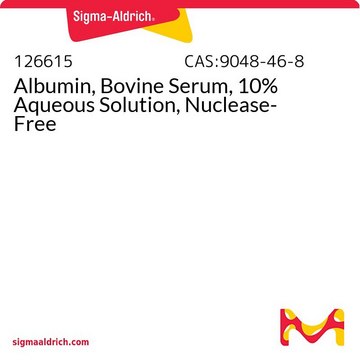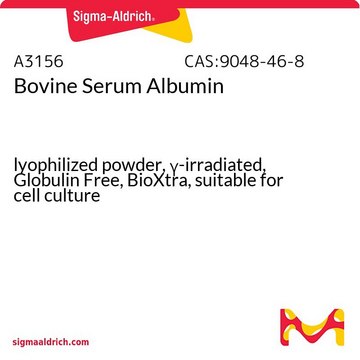A0281
Albumine de sérum bovin
lyophilized powder, essentially fatty acid free and essentially globulin free, ≥99% (agarose gel electrophoresis)
Synonyme(s) :
Albumine bovine, Albumine, sérum bovin, BSA, ASB
About This Item
Produits recommandés
Source biologique
bovine
Essai
≥99% (agarose gel electrophoresis)
Forme
lyophilized powder
Poids mol.
~66 kDa
Produit purifié par
cold ethanol and heatshock fractionation
Conditionnement
poly bottle of
Origine
USA origin
free fatty acid content
≤0.01%
Technique(s)
enzyme immunoassay: suitable
Impuretés
essentially globulin free
≤0.01% Fatty acids
pH
7
Solubilité
water: soluble (40 mg/ml)
Numéro d'accès UniProt
Température de stockage
2-8°C
Informations sur le gène
bovine ... ALB(280717)
Vous recherchez des produits similaires ? Visite Guide de comparaison des produits
Description générale
This BSA product is specifically tested for the following properties:
- very low FA content / essentially fatty acid free
- low globulin content / essentially globulin free
Application
Actions biochimiques/physiologiques
Caractéristiques et avantages
- Essentially fatty acid-free
- Essentially globulin-free
Notes préparatoires
Code de la classe de stockage
11 - Combustible Solids
Classe de danger pour l'eau (WGK)
WGK 3
Point d'éclair (°F)
Not applicable
Point d'éclair (°C)
Not applicable
Équipement de protection individuelle
Eyeshields, Gloves, type N95 (US)
Faites votre choix parmi les versions les plus récentes :
Certificats d'analyse (COA)
Vous ne trouvez pas la bonne version ?
Si vous avez besoin d'une version particulière, vous pouvez rechercher un certificat spécifique par le numéro de lot.
Déjà en possession de ce produit ?
Retrouvez la documentation relative aux produits que vous avez récemment achetés dans la Bibliothèque de documents.
Les clients ont également consulté
Notre équipe de scientifiques dispose d'une expérience dans tous les secteurs de la recherche, notamment en sciences de la vie, science des matériaux, synthèse chimique, chromatographie, analyse et dans de nombreux autres domaines..
Contacter notre Service technique



